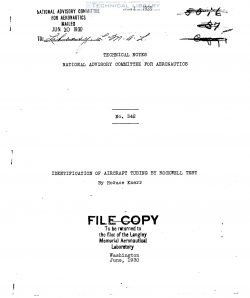naca-tn-342
- Version
- 152 Downloads
- 569.95 KB File Size
- 1 File Count
- November 24, 2016 Create Date
- November 24, 2016 Last Updated
National Advisory Committee for Aeronautics, Technical Notes - Identification of Aircraft Tubing by Rockwell Test

Seamless steel tubing is to—day the principal material of
construction for aircraft. The commercial grade of tubing con—
taining about 0.10 to 0.30% carbon at first used is being super— __
seded by two grades which are approved by the army and navy, and
which are also becoming standard for commercial airplanes, whose
composition is given below:
Steel #1025 Steel #4130X
straight carbon chrome molybdenum
Carbon ..... ........ .20—.30 Carbon ............. .25—.35
Manganese ... ....... .50—.80 Manganese .. ....... . .40—.60
Phosphorus max. .... .045 Phosphorus max. .... .04
Sulphur max. ...... . .05 Sulphur max. ....... .045
Chromium .......... . .80—l.10
Molybdenum ........ . .15—.85
(A 3%% nickel steel was formerly employed in aircraft con—
struction, where high strength Was required, but this is being
abandoned in favor of chrome molybdenum steel because of the
superior characteristics of the latter.)
The physical properties of the two standard steels, in the
normalized condition, are as follows:
Steel #1085 ' Steel #413OX
straight carbon chrome molybdenum
Yield point (min.) 36,000 Yield point (min.)..... 60,000
Tensile strength ..... 55,000 Tensile strength ...... 95,000
Elongation in 2-" 227. Elongation in 2" 12%
The above properties are minimum values and are ordinarily
considerably exceeded. Steel #4130X can, by heat treatment con—
sisting of quenching in oil from about lBOOOF., followed by
suitable tempering, be given extremely good physical properties
such as are shown in following table:
Physical preperties — Pounds per square inch
Tensile strength 185,000 150,000 135,000 200,000
Yield point 110,000 130,000 140,000 150,000
Elongation in 2" 11-73 9% 3% 5%
Axles, landing gears, wing beams, and other parts reQuiring
high strength are made of chrome molybdenum steel heat—treated
after assembly. The major part of both types of steel is used
in the construction of airplane fuselages assembled by welding
As it is ordinarily impracticable to heat—treat an assembled
fuselage, design factors are based on the strength of the tubing
in the normalized condition. Most aircraft builders prefer to
have the mild carbon steel in a slightly harder state than re—
sults from normalizing, and it is moderately tempered by the
tube mill after cold drawing, so that 3t has a tensile strength
in the neighborhood of 60,000 to 65,000 pounds per square inch.
The chrome molybdenum tube is, however, normalized by the tubing
manufacturer. This treatment consists in heating it to lGOOOF.
| File | Action |
|---|---|
| naca-tn-342 Identification of Aircraft Tubing by Rockwell Test.pdf | Download |

Comment On This Post